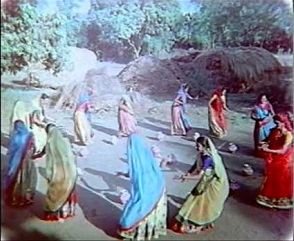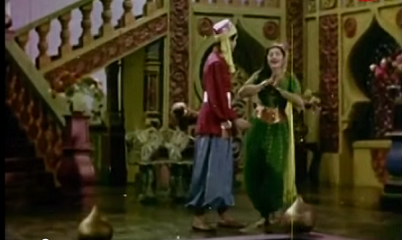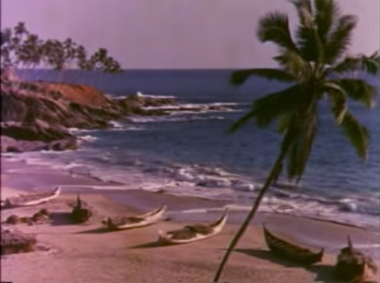Colour films in India
Readers can send additional information, corrections, photographs and even |

All three pioneering films were entirely in colour.
No moving pictures from Shahenshah exist anymore. This probably is the only colour still from the film that survives.
The above image has been cropped somewhat at the bottom. The complete image, but with weaker colours, can be seen on the page Colour films in Hindi-Urdu

Indpaedia finds this photograph so revolting that we have violated the alphabetical order and put it at the bottom, despite its historic value.
Contents |
The first colour films of India
India was the sixth country to produce a colour film (at most seventh, if firmer dates about the first Soviet colour film indicate otherwise).
For a history of the first colour films of India, see Colour films in Hindi-Urdu
Hand-tinted films
Sources: Chit Dukhira, LeMauricien
In the 1940s some films made in Bombay and Madras were ‘hand-tinted' This meant that human artists painted colours on every frame of the positive print with their hands. This was a tedious and labour-intensive procedure.
As far as still photographs are concerned, most Indian small towns with a respectable photo studio would have at least one artist who would colourise black and white prints with their hands. For instance, a studio in Shahbad, Haryana, was doing this till the late 1960s.
Moving images were vastly more difficult. Artists needed specialised training so that the colours did not jump up and down from frame to frame. The Hindu informs us that, an 'advocate of Madras had a company undertaking ‘Hand Tinting,' and a technician Murugesan was expert at doing such sequences.'
K. Subramanyam's mythological Bhaktha Chetha (1940/ Tamil), starring Vethala had some tinted sequences. So did Vethala Ulagam and Haridas'.'
Parts of Shakuntala (1943/ HIndi and possibly Marathi as well) by V. Shantaram (1901-1993) were hand tinted. The film was screened continuously at Bombay's Swastik theatre for 104 weeks. A hand-coloured print of the film was screened in the 25th week.
This writer has come upon one stray suggestion that Mangama Sabatham (1943/ Tamil) had tinted scenes. This, incidentally, was the debut film of Vasunthara Devi, the mother of actress Vaijayanthimala.
Bhaskar Pictures' Saalivaahanan (1945/ Tamil/ dir B.N. Rao) was one of the earliest films made in India that had a hand-tinted scene. A romantic scene between Ranjan and Rajakumari (who played a princess) had been hand-tinted (The legendary M.G. Ramachandran played Vikramaditya, a villain in the film and Ranjan the eponymous hero, Saalivaahanan.)
The early days: 'Partly in colour’ films; Gevacolor films
The following aims to be a complete record of the first colour films in India, which really means the first colour films in Hindi-Urdu, Tamil, Kannada, Malayalam and Telugu. Additional information, corrections, photographs and even complete articles on new subjects to the Facebook page, Indpaedia.com.
There are more details on the page Colour films in Hindi-Urdu
The early days
Kalyanam Panni Paar (1952, Tamil) First Tamil and first South Indian film with a colour insert (the song "Engu Sendraayo").
Shahenshah (1953, Hindi- Urdu) First full length Indian film shot in Gevacolor. .No colour print of the film seems to have survived
Kanavaney Kankanda Deivam (1955/ Tamil) The song "Jagajothiye" and dance sequence in the climax were in colour
Alibabavum 40 Thirudargalum (1956/ Tamil ) first Tamil and South Indian full-length colour film.
Marma Veeran (1956/ Tamil ) Partly in colour
Kannin Manigal (1956/ Tamil ) Partly in colour
Thangamalai Ragasiyam (1957/ Tamil ) Had one photographer for the main black and white film and another for the song "Ehalogame", which was in Gevacolour
Rathnagiri Rahasya (1957/ Kannada) It was the Kannada version of Thangamalai Ragasiyam. Both films were shot simultaneously, with the same lead actress but with different leading men. Kannada had stolen a march over the much bigger Telugu industry
Ambikapathy (1957/ Tamil) Partly in colour
Allaudinum Arputha Vilakkum (1957/ Tamil ) Partly in colour
After this, there were several Tamil films that had a song—normally a dance accompanied by a song—in Gevacolor. Almost the entire second half of Nadodi Mannan (1958/ Tamil ) was in Gevacolor. In the late 1950s, every year there would be two or three Tamil films that were ‘partly in colour’—normally Gevacolor. The number of such films increased every year.
Allavuddin Adbhuta Deepam (1957/ Telugu ) Partly in colour. Arguably the first Telugu film with any colour scenes at all.
School Master (1958/ Kannada ) Partly in colour
Appu Chesi Pappu Koodu (1958/ Telugu) Partly in colour
Deiva Balam (1959/ Telugu) The second half and some other sequences were in Gevacolor.
Veerapandiya Kattabomman (1959/ Tamil ) This entire magnum opus was in colour. The whole film was shot in Gevacolor but its prints were in Technicolor.
Athisaya Penn (1959/ Tamil ) The film was a remake of the Hindi film Aasha (1957). While most of the film was in Gevacolor, the 45-minute climax was in ‘scintillating Technicolor.’ Thus, this was the first Tamil film, the first South Indian film and, after Asha, the second Indian film a portion of which was shot in Technicolor.
Makkala Rajya (1960/ Kannada ) Partly in Gevacolor
Runanubandham (1960/ Telugu) Partly in Gevacolor
Sri Valli (1961, Tamil) The film was entirely in Gevacolor
Sabarimala Sri Ayyappan (1961, Malayalam) The only Malayalam film in Gevacolor
Lava Kusa (1963/ Tamil) This was the last Tamil film to be shot in Gevacolor
Lava Kusa (1963/ Telugu) This was the first full-length Telugu film to be shot in colour, i.e. Gevacolor.
Sachcha Jhootha (1970/ Hindi- Urdu) This was the last Hindi- Urdu film to be shot in Gevacolor
LANGUAGE-WISE
Assamese

Shakuntala (1961/ dir: Dr. Bhupen Hazarika) was the first Assamese feature film with some sequences in colour.
The first colour film was Kamal Narayan Choudhury's Bhaity (1972).
'Ajali Nabou' (1980), directed by Nip Baruah, was the first Assamese film in Eastmancolour.
(No colour photographs are available in public from Shakuntala. The article Assamese cinema has a B&W still from Shakuntala, though. Can any reader help?)
Indpaedia has located a short colour clip from 'Bhaity': is it the same as the Assamese film of that name? We are posting it on the page Bhaity in the hope that it is from the film.
Meanwhile, the entire film Ajali Nabou is available on youtube. Therefore, there can be no doubts about the authenticity of its colour photgraphs
Bengali
Kanchanjangha (Bengali: কাঞ্চনজঙ্ঘা Kanchonjônggha) (1962) written and directed by Satyajit Ray is arguably the first colour film in Bengali, Indian or East Pakistani. It was in Eastmancolour, which is more fragile than Technicolor. By the 1970s all complete colour prints of the film were lost and an international effort got together portions of the film available around them world, edited them together into a whole and restored the faded colours.
Bhojpuri
Bhojpuri:first colour movie, Dangal (1977), starring Sujit Kumar and Prema Narayan.
Gujarati
First Gujarat colour film: Liludi Dharti (1968).
Director: Vallabh Chokshi
Hindi-Urdu
See the main entry Colour films in Hindi-Urdu
Prabhat Film Company's‘Sairandhri' (1933/ Hindi and Marathi versions/ dir: V. Shantaram) was the Indian first film to be shot in colour. However, the prints that were screened were in monochrome, apparently because of shoddy processing in Germany.
Ardeshir Irani established India's first colour film processing studio in Bombay in 1937.
Kisan Kanya (lit: the peasant girl; 1937/ Dir: Moti B. Gidvani; prod. Ardeshir Irani) was arguably the first colour film to be actually released in Hindi-Urdu, and the first colour film of India and of South Asia. Only the colour poster of the film survives.
Kannada
‘Stree Ratna' (Kannada-1954) had some sequences in colour.
The first full-length colour film in Kannada, Amarashilpi Jakanachar [Jaggannachari], was released in 1964
Malayalam
‘Jeevitha Nauka' (1951) had one sequence in colour.
The first full-length Malayalam colour film was Kandam Vecha Coat (1961/ dir: T. R. Sundaram). It was produced by Modern Theatres, which had made the first Malayalam ‘talkie’ Balan (1938).
According to B. Vijayakumar, Kandam Vecha Coat was in Eastman colour and ‘was probably the first Malayalam film to use a movie trailer for the marketing of the film.’ (TheHindu, November 7, 2011)
Pakshiraja Studios’ Sabarimala Sree Ayyappan, (Gevacolor/1961), a mythological film, followed a few months later.
Udaya Studios’ Bharya (1962), Kadalamma (1963), Shakuntala (1965) and Pearl View (1970), some films from other studios, had a few sequences in colour.
Chemmeen (1965), in full-length Eastmancolor, was a critical and commercial success. With music by Salil Chaudhary its songs were popular all over India. It won the President of India's Gold Medal for the best feature film in India.
The full-length colour films that followed were ‘Kallichellamma' (1969), ‘Nadhi,' ‘Kumaraambhavam' (1969), 'Triveni' (1970), ‘Karakanakkadal' (1971), ‘Panitheeratha Veedu' (1972), ‘Nakhangal' (1973), ‘Chattakkari,' and ‘Nellu' (1974).
Manipuri
Langlen Thadoi (1984) by MA Singh (Maibam Amuthoi Singh) is the first colour feature film in Manipur produced by K.P Films International in 1984
(No photograph available. Can any reader help?)
Marathi
Sairandhri (1933), processed and printed in Germany; would have been the first colour film in Marathi, and also India's first colour film. However, its processing was not successful. It was shot on Agfa B&W 35-mm negative. The release prints were made in Germany by Bipack colour printing, which, as mentioned, did not result in the print being in colour. All surviving stills from the film are in black & white.
So, the question is, which was the second colour film in Marathi, because Sairandhri’s final, released print was not in colour.
There is one theory, that Pinjra (1972) 'led to the introduction of colour films in Marathi cinema.' [1] It is difficult to believe that colour took that long to reach Marathi cinema, but the fact is that Marathi cinema was among the last in India to produce a CinemaScope film. (See CinemaScope films in Bangladesh, India, Nepal, Pakistan, Sri Lanka.)
Odiya/ Oriya
The first Oriya Colour Movie was "Gapa Helevi Sata" (1976) though 'Samaya' (1975) was partially coloured).
Punjabi
Indian Punjabi
Nanak Nam Jahaz Hai (Punjabi: ਨਾਨਕ ਨਾਮ ਜਹਾਜ਼ ਹੈ), a 1969 National Award winning Punjabi film directed by Ram Maheshwary, was the first Indian colour film in Punjabi. The film's colours were digitally enhanced and the film was re-released in 2015.
Tamil
Haridas (Tamil-1944) and Naam Iruvar (Tamil-1947) had some sequences in colour.
The first Tamil film ‘entirely in colour’ was Alibabavum Narpadhu Thirudargalum-1956 (Geva Color)
Telugu
See the page Colour films in Telugu
First ‘entirely in colour’ film Lavakusa (1963/ GevaColor).
First Eastmancolor film Eenadu (1982)
See also
Colour films in India
CinemaScope films in Bangladesh, India, Nepal, Pakistan, Sri Lanka I.e. the first part of this article
70mm films in India/ South Asia












